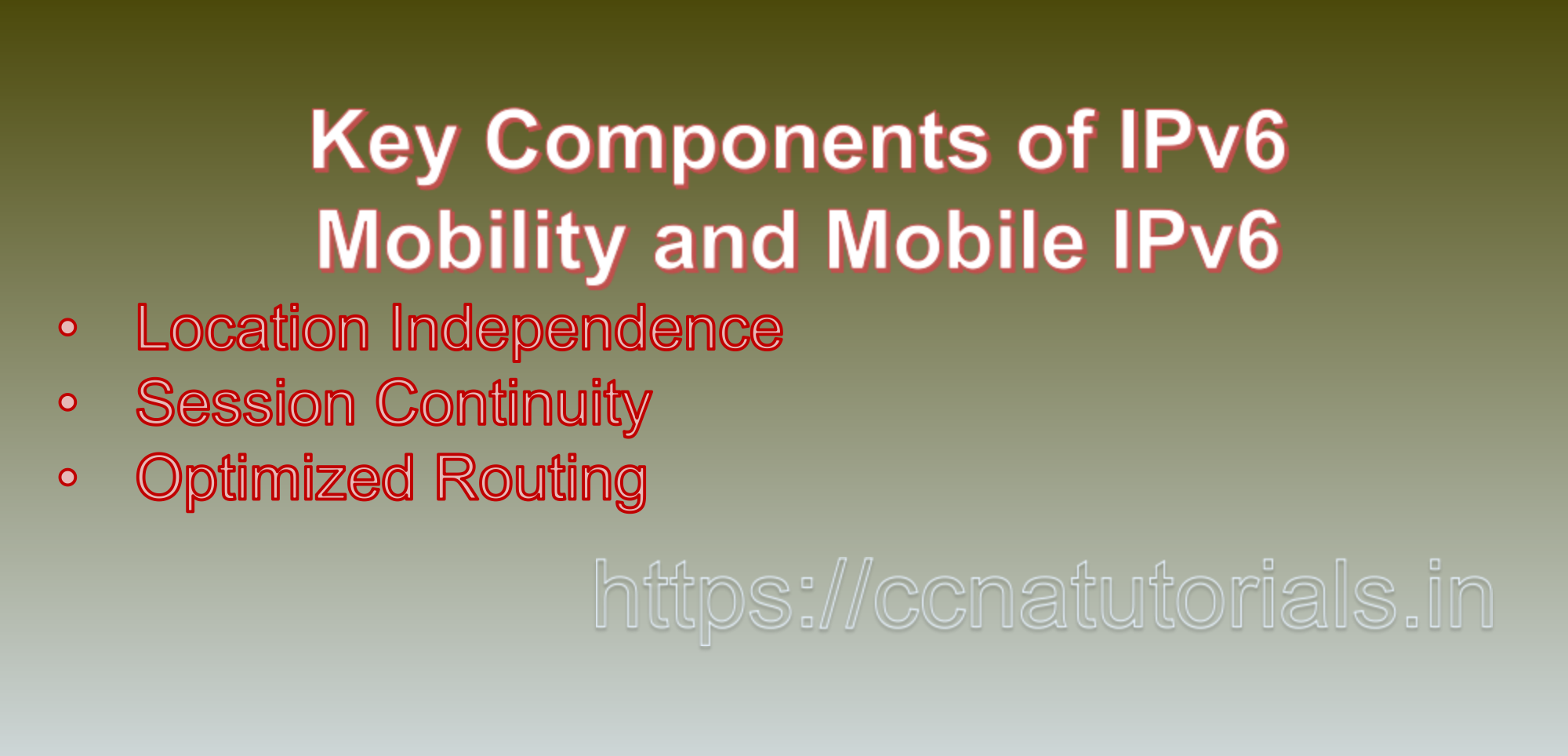Contents of this article
In this article, I describe IPv6 Mobility and Mobile IPv6: Enabling Seamless Roaming and Connectivity IPv6 Mobility and Mobile IPv6 are essential concepts in networking that address the challenge of maintaining continuous connectivity for mobile devices as they move between different networks. Mobile devices, such as smartphones and laptops, often switch between Wi-Fi networks, cellular networks, and other types of connections. IPv6 Mobility and Mobile IPv6 provide the framework to ensure that these devices can maintain their established connections and communication regardless of their physical location. In this article, we will explore the fundamentals of IPv6 Mobility and Mobile IPv6, along with a real-world example to illustrate their significance.
IPv6 Mobility:
IPv6 Mobility refers to the capability of a mobile device to change its point of attachment to the Internet without losing its established connections or requiring manual reconfiguration. This capability is particularly crucial as more devices become mobile and users expect continuous connectivity as they move between different network environments.
Key Aspects of IPv6 Mobility:
1. Location Independence:
IPv6 Mobility ensures that a mobile device can change its point of attachment (e.g., from Wi-Fi to cellular) while maintaining its IP address and active connections.
2. Session Continuity:
Mobile devices can seamlessly continue ongoing sessions, such as VoIP calls or streaming, as they switch between different networks.
3. Optimized Routing:
IPv6 Mobility allows for the optimization of routing paths, ensuring that traffic takes the most efficient route to the mobile device’s current location.
Mobile IPv6:
Mobile IPv6 is a protocol designed to implement IPv6 Mobility. It enables mobile devices to move between different networks while maintaining their IP addresses and ongoing communications. Mobile IPv6 introduces the concept of a “home network” and a “care-of address” to achieve seamless roaming.
Key Components of Mobile IPv6:
1. Home Network:
The home network is the network where a mobile device’s permanent IP address is registered. Even when the device moves away from the home network, it retains its home address.
2. Care-of Address:
The care-of address is the temporary IP address assigned to the mobile device in its current location. It allows the device to receive packets sent to its home address while on a different network.
3. Binding Update:
When a mobile device moves to a new network, it informs its home network of its current care-of address through a binding update.
4. Reverse Tunneling:
Incoming packets sent to the device’s home address are tunneled to its care-of address on the current network.
Example Scenario of IPv6 Mobility and Mobile IPv6:
Imagine a user carrying a smartphone that is connected to their home Wi-Fi network. They start a VoIP call and then leave their home, transitioning to a cellular network.
1. Home Network:
The home network, where the smartphone’s permanent IP address is registered, is the user’s Wi-Fi network.
2. Care-of Address:
As the smartphone switches to the cellular network, it receives a temporary care-of address from the cellular network.
3. Binding Update:
The smartphone sends a binding update to its home network, informing it of the new care-of address.
4. Reverse Tunneling:
When the VoIP call’s packets are sent to the smartphone’s home address, they are tunneled to the smartphone’s current care-of address on the cellular network.
Thanks to Mobile IPv6, the VoIP call remains uninterrupted as the smartphone switches from Wi-Fi to cellular. The binding update and reverse tunneling mechanisms ensure that communication is maintained even as the device’s location changes.
In short IPv6 Mobility and Mobile IPv6:
IPv6 Mobility and Mobile IPv6 play a vital role in addressing the challenges of seamless connectivity for mobile devices in a dynamic network environment. By allowing devices to move between different networks while maintaining their IP addresses and active sessions, these concepts empower users to stay connected regardless of their physical location. The example scenario demonstrates how Mobile IPv6 ensures continuous VoIP communication as a mobile device transitions from one network to another. As the world becomes increasingly mobile-centric, IPv6 Mobility and Mobile IPv6 remain essential tools for delivering reliable and uninterrupted network services to users on the move.

IPv6 Mobility and Mobile IPv6 are essential components of modern networking that address the challenges posed by mobile devices and users in an increasingly connected world. These technologies facilitate seamless communication for devices that move across different networks, ensuring uninterrupted connectivity and efficient data transmission. This article provides an in-depth explanation of IPv6 Mobility and Mobile IPv6, along with a real-world example to illustrate their significance.
IPv6 Mobility:
IPv6 Mobility refers to the ability of a device to maintain its connectivity and communication capabilities while moving across different networks. As mobile devices like smartphones, tablets, and laptops become ubiquitous, IPv6 Mobility becomes crucial to ensure uninterrupted service delivery and efficient handover between different access points.
Challenges Addressed by IPv6 Mobility:
1. Handover:
When a mobile device moves from one network to another, it needs to smoothly transition its connection without disrupting ongoing communication.
2. Routing:
Traditional routing relies on static IP addresses that don’t change. In mobile scenarios, devices need to maintain connectivity even as they change locations and obtain new IP addresses.
3. Session Continuity:
Mobile users expect their sessions (such as ongoing calls or downloads) to remain active even when transitioning between networks.
Mobile IPv6:
Mobile IPv6 (MIPv6) is a protocol that enables IPv6 Mobility by allowing mobile devices to maintain their established connections and IP addresses while moving across different networks. MIPv6 achieves this by introducing the concept of a “home network” where the device’s permanent IP address resides, and a “care-of address” that the device obtains from the current network it is connected to.
Key Components of Mobile IPv6:
1. Home Agent (HA):
The Home Agent is a router in the home network that maintains the device’s permanent IP address. It intercepts packets destined for the device and forwards them to the device’s current location.
2. Mobile Node (MN):
The Mobile Node is the mobile device itself, which can move between different networks while maintaining its IP connectivity.
3. Foreign Agent (FA):
The Foreign Agent is a router in the visited network that assists the Mobile Node by providing a care-of address. It forwards packets between the Home Agent and the Mobile Node.
Example Scenario:
Imagine a person using a laptop to participate in a video conference while traveling between home and work. Here’s how Mobile IPv6 ensures seamless connectivity:
1. Initial Connection (Home Network):
The person’s laptop connects to their home Wi-Fi network. The Home Agent assigns a permanent IP address to the laptop.
2. Travel to Work (Visited Network):
The person leaves home and arrives at work. Their laptop connects to the work Wi-Fi network. The Foreign Agent in the work network assigns a care-of address to the laptop.
3. Ongoing Video Conference:
Despite the change in networks, the video conference continues uninterrupted. The Home Agent forwards incoming video conference packets to the laptop’s current location using the care-of address.
4. Returning Home:
When the person returns home, the laptop switches back to the home network. The Home Agent resumes delivering packets directly to the laptop’s permanent IP address.
Benefits of Mobile IPv6:
1. Seamless Handover: Mobile IPv6 ensures that connections remain uninterrupted even as devices move between networks.
2. Optimized Routing: Mobile IPv6 dynamically routes packets to the device’s current location, improving efficiency.
3. Session Continuity: Ongoing sessions like calls or downloads are maintained during network transitions.
4. Global Reachability: Mobile IPv6 allows devices to maintain connectivity even across different geographical regions.
Conclusion for IPv6 Mobility and Mobile IPv6:
IPv6 Mobility and Mobile IPv6 are crucial technologies for today’s mobile-centric world. By allowing devices to maintain connectivity as they move between networks, these technologies enable seamless communication and uninterrupted services. The example scenario demonstrates how Mobile IPv6 ensures a video conference session continues without disruption while a person moves between home and work networks. As the number of mobile devices continues to rise, IPv6 Mobility and Mobile IPv6 play a vital role in ensuring efficient, reliable, and global communication for users on the move. You may contact us for any query related to this article.






